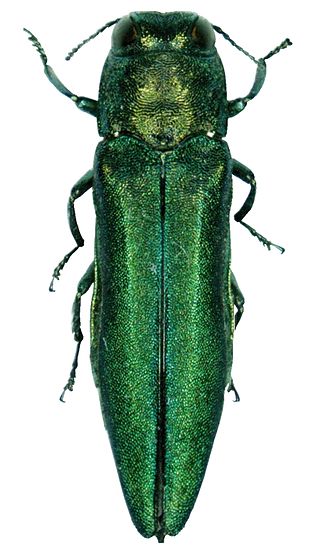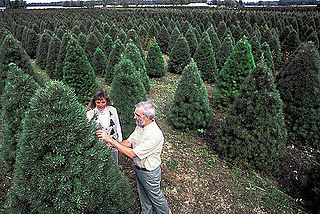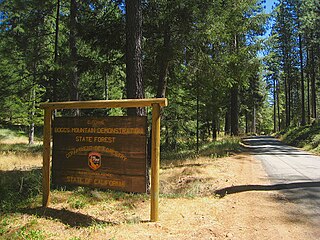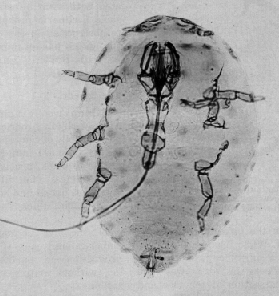Related Research Articles

The emerald ash borer, also known by the acronym EAB, is a green buprestid or jewel beetle native to north-eastern Asia that feeds on ash species. Females lay eggs in bark crevices on ash trees, and larvae feed underneath the bark of ash trees to emerge as adults in one to two years. In its native range, it is typically found at low densities and does not cause significant damage to trees native to the area. Outside its native range, it is an invasive species and is highly destructive to ash trees native to Europe and North America. Before it was found in North America, very little was known about emerald ash borer in its native range; this has resulted in much of the research on its biology being focused in North America. Local governments in North America are attempting to control it by monitoring its spread, diversifying tree species, and through the use of insecticides and biological control.

The mountain pine beetle is a species of bark beetle native to the forests of western North America from Mexico to central British Columbia. It has a hard black exoskeleton, and measures approximately 5 millimetres, about the size of a grain of rice.
Forest integrated pest management or Forest IPM is the practice of monitoring and managing pest and environmental information with pest control methods to prevent pest damage to forests and forest habitats by the most economical means.

The term woodboring beetle encompasses many species and families of beetles whose larval or adult forms eat and destroy wood. In the woodworking industry, larval stages of some are sometimes referred to as woodworms. The three most species-rich families of woodboring beetles are longhorn beetles, bark beetles and weevils, and metallic flat-headed borers. Woodboring is thought to be the ancestral ecology of beetles, and bores made by beetles in fossil wood extend back to the earliest fossil record of beetles in the Early Permian (Asselian), around 295-300 million years ago.

The American Elm cultivar Ulmus americana 'Princeton' was originally selected in 1922 by New Jersey nurseryman William Flemer of Princeton Nurseries for its aesthetic merit. 'Princeton' was later found to have a moderate resistance to Dutch elm disease (DED).

Beech bark disease is a disease that causes mortality and defects in beech trees in the eastern United States, Canada and Europe. In North America, the disease occurs after extensive bark invasion by Xylococculus betulae and the beech scale insect, Cryptococcus fagisuga. Through a presently unknown mechanism, excessive feeding by this insect causes two different fungi to produce annual cankers on the bark of the tree. The continuous formation of lesions around the tree eventually girdles it, resulting in canopy death. In Europe, N. coccinea is the primary fungus causing the infection. Infection in European trees occurs in the same manner as it does in North American trees. Though the disease still appears in Europe, it is less serious today than it once was.

Carya glabra, the pignut hickory, is a common, but not abundant species of hickory in the oak-hickory forest association in the Eastern United States and Canada. Other common names are pignut, sweet pignut, coast pignut hickory, smoothbark hickory, swamp hickory, and broom hickory. The pear-shaped nut ripens in September and October, has a sweet maple like smell, and is an important part of the diet of many wild animals. The wood is used for a variety of products, including fuel for home heating. Its leaves turn yellow in the Fall.
Salvage logging is the practice of logging trees in forest areas that have been damaged by wildfire, flood, severe wind, disease, insect infestation, or other natural disturbance in order to recover economic value that would otherwise be lost.

Pine and fir trees, grown purposely for use as Christmas trees, are vulnerable to a wide variety of pests, weeds and diseases. Many of the conifer species cultivated face infestations and death from such pests as the balsam woolly adelgid and other adelgids. Aphids are another common insect pest. Christmas trees are also vulnerable to fungal pathogens and their resultant illnesses such as root rot, and, in the U.S. state of California, sudden oak death. Douglas-fir trees in particular are vulnerable to infections from plant pathogens such as R. pseudotsugae.

Boggs Mountain Demonstration State Forest is a state forest in Lake County, California that covers the northwest of Boggs Mountain. It was founded in 1949, and came into operation in 1950 when most of the site had been clear cut. The purpose was to demonstrate good practices in restoring and managing a forest. The state forest was open for recreational use, including camping, hiking, mountain biking etc. The 2015 Valley Fire destroyed 80% of the trees. The state forest as of 2021 was replanting saplings.
The mountain pine beetle has killed large numbers of the lodgepole pine trees in the northern mountains of the US state of Colorado. The more recent outbreak of another bark beetle pest, the spruce beetle, is threatening higher-elevation forests of Engelmann spruce. Chemical prevention is effective but too costly for large-scale use. Dead trees increase the incidence of wildfires. Uses have been found for the dead wood including composting and in construction, and potentially to make biochar.

Cryptococcus fagisuga, commonly known as the beech scale or woolly beech scale, is a felted scale insect in the superfamily Coccoidea that infests beech trees of the genus Fagus. It is associated with the transmission of beech bark disease because the puncture holes it makes in the bark allow entry of pathogenic fungi which have been identified as Nectria coccinea var. faginata and sometimes Nectria galligena.

Balsam woolly adelgids are small wingless insects that infest and kill firs. In their native Europe they are a minor parasite on silver fir and sicilian fir, but they have become a threat especially to balsam fir and Fraser fir after they were introduced to the United States around 1900.

The European spruce bark beetle, is a species of beetle in the weevil subfamily Scolytinae, the bark beetles, and is found from Europe to Asia Minor and some parts of Africa.

Wildfires are outdoor fires that occur in the wilderness or other vast spaces. Other common names associated with wildfires are brushfire and forest fire. Since wildfires can occur anywhere on the planet, except for Antarctica, they pose a threat to civilizations and wildlife alike. In terms of emergency management, wildfires can be particularly devastating. Given their ability to destroy large areas of entire ecosystems, there must be a contingency plan in effect to be as prepared as possible in case of a wildfire and to be adequately prepared to handle the aftermath of one as well.

The School Fire was a wildfire that occurred in the US state of Washington in August 2005, so named due it to beginning in School Canyon. The fire originated in the Umatilla National Forest in southeastern Washington, in Columbia and Garfield Counties. The School Fire was detected from space by NASA's Terra satellite. The fire burned around 51,892.13 acres, destroying over 100 houses and 100 outbuildings. The largest wildfire of 2005 in the contiguous United States, the School Fire's smoke was seen as far away as Walla Walla. Its total damage was estimated at $15 million.

The Rim Fire was a massive wildfire that started in a remote canyon in Stanislaus National Forest, in California. This portion of the central Sierra Nevada spans Tuolumne and Mariposa counties. The fire started on August 17, 2013, during the 2013 California wildfire season, and grew to be the second-largest wildfire in California's recorded history and the largest recorded in the Sierra Nevada, having burned 257,314 acres. As of 2022, the Rim Fire was California's 11th-largest modern wildfire. The Rim Fire was fully contained on Thursday, October 24, 2013, after a nine-week suppression effort by firefighters. Due to a lack of winter rains, some logs smoldered in the interior portion of the fire footprint throughout the winter. More than a year passed before it was declared out on November 4, 2014.

The Barry Point Fire was a wildfire that burned over 92,977 acres (376.26 km2) of Oregon and California forest land during the summer of 2012. The fire began on 5 August 2012, the result of a lightning strike. The fire consumed public forest and rangeland as well as private forest and grazing land located in Lake County, Oregon and Modoc County, California. The public lands effected by the fire are administered by the United States Forest Service and the Oregon Department of Forestry. The largest part of the private land was owned by the Collins Timber Company. At the peak of the firefighting effort, there were 1,423 personnel working on the fire. It took 22 days to fully contain the fire and then an additional three weeks to mop it up.

Pissodes nemorensis, known generally as the eastern pine weevil or deodar weevil, is a species of true weevil in the beetle family Curculionidae. It is found in North America and Africa. Deodar weevils are considered a forest pest in the United States, with adults and larvae feeding on a variety of coniferous tree species, including trees such as deodar cedar, loblolly pine, longleaf pine, sand pine, shortleaf pine, slash pine, and spruce pine Trees of all ages are susceptible to weevil infestations, while trees that are severely stressed by fire, drought, extreme cold, fusiform rust, wind damage, and other problems are prone to weevil infestation. In well-managed pine stands, deodar weevil infestations are sporadic, attacking only the suppressed and unhealthy trees throughout the area. Because they do not typically effect healthy trees, they do not usually alter traditional management strategies. Unlike many other forest pests in the eastern United States, deodar weevils are most active in the winter months, and this is often when sign of infestations can be seen. The best way to avoid a deodar weevil infestation is to maintain good tree and stand health: healthy trees do not typically face mortality or extensive damage from these pests. If an infestation has occurred, pesticides can be used in the fall as the weevils become active, but are typically not recommended.
References
- ↑ Womach, Jasper (2005-09-16). Report for Congress: Agriculture: A Glossary of Terms, Programs, and Laws, 2005 Edition (Report). Congressional Research Service. p. 217.
 This article incorporates text from this source, which is in the public domain .
This article incorporates text from this source, which is in the public domain .